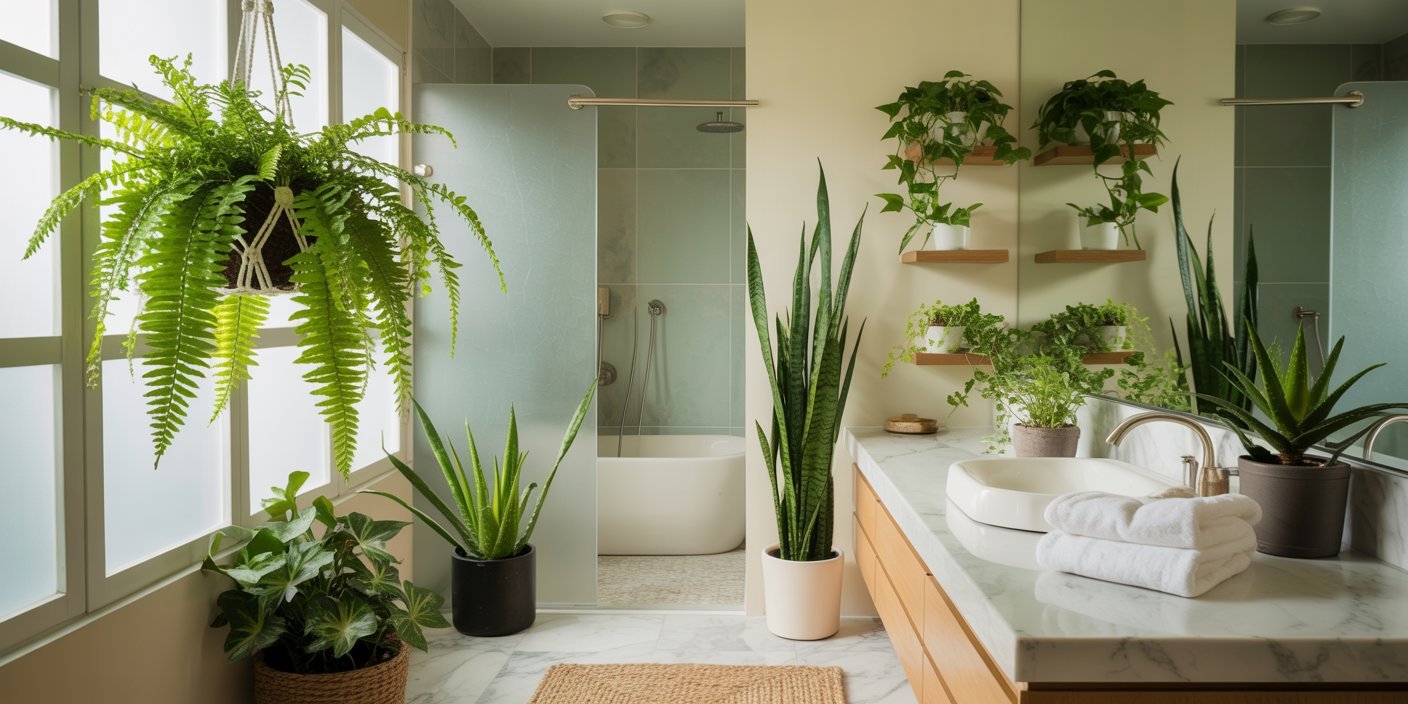Bathrooms can be tricky when it comes to plants. The constant moisture, limited natural light, and fluctuating temperatures make it tough for many species to thrive.
But over the years, I’ve discovered that a few special plants not only survive but actually benefit from humidity — and they bring so much life and freshness to the space.
I’ve always loved the idea of combining functionality with beauty. That’s when I started experimenting with moisture-absorbing plants in my bathroom.
Not only do they help reduce excess humidity, preventing mold and mildew, but they also make the space feel fresh, airy, and inviting.
I’ve noticed that simply having plants around changes the vibe — the bathroom becomes more relaxing, spa-like, and even a little luxurious.
Over time, I’ve curated a list of my favorites — plants that are low-maintenance, thrive in humid conditions, and actually help improve the air quality.
In this post, I’ll share my top 8 moisture-absorbing bathroom plants, how to care for them, where to place them, and tips to make them flourish even in smaller or darker bathrooms.
1. Boston Fern (Nephrolepis exaltata)
The Boston Fern has been my go-to for bathrooms for years. I love its feathery, lush fronds that seem to soften any space, instantly making the bathroom feel more spa-like.
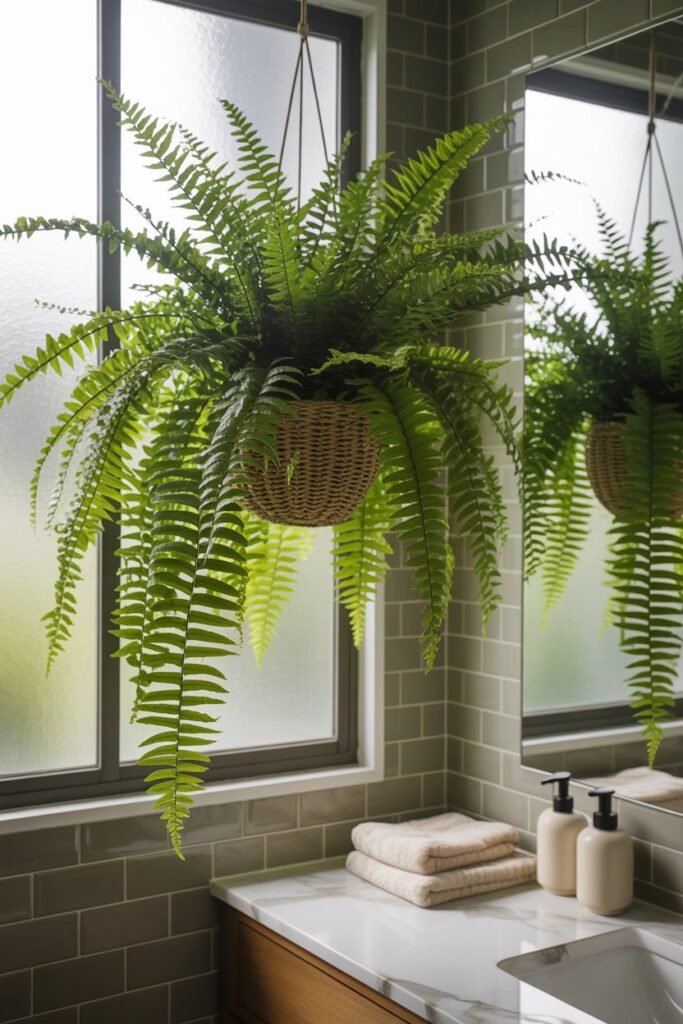
What’s amazing is that it actually thrives on the humidity from showers, which makes it perfect for bathrooms where many other plants would struggle.
I’ve noticed that after a few weeks, the air feels fresher, and the plant seems to help keep moisture under control, reducing that stuffy, damp smell that bathrooms sometimes get.
How to Care for It:
- Place it in indirect light — near a north-facing window or in a spot where sunlight filters through frosted glass. Too much direct sun can scorch the leaves.
- Keep the soil consistently moist, but avoid letting the roots sit in water. I water mine every 2–3 days in summer and less frequently in winter, adjusting based on the humidity in my bathroom.
- Misting the fronds regularly keeps the leaves lush and helps the plant absorb extra humidity. I often do this after my evening shower when the bathroom is naturally humid.
Pro Tip: Hanging your Boston Fern from a ceiling hook or placing it on a high shelf gives the fronds room to cascade freely.
Not only does it look gorgeous, but it also keeps the plant safe from splashes while still letting it enjoy the humid environment.
Over time, the cascading fronds create a soft, airy feel that makes even a small bathroom feel luxurious.
2. Peace Lily (Spathiphyllum)
The Peace Lily is another favorite. I remember buying my first one for a bathroom with very little natural light, and to my surprise, it not only survived but thrived in the humidity.
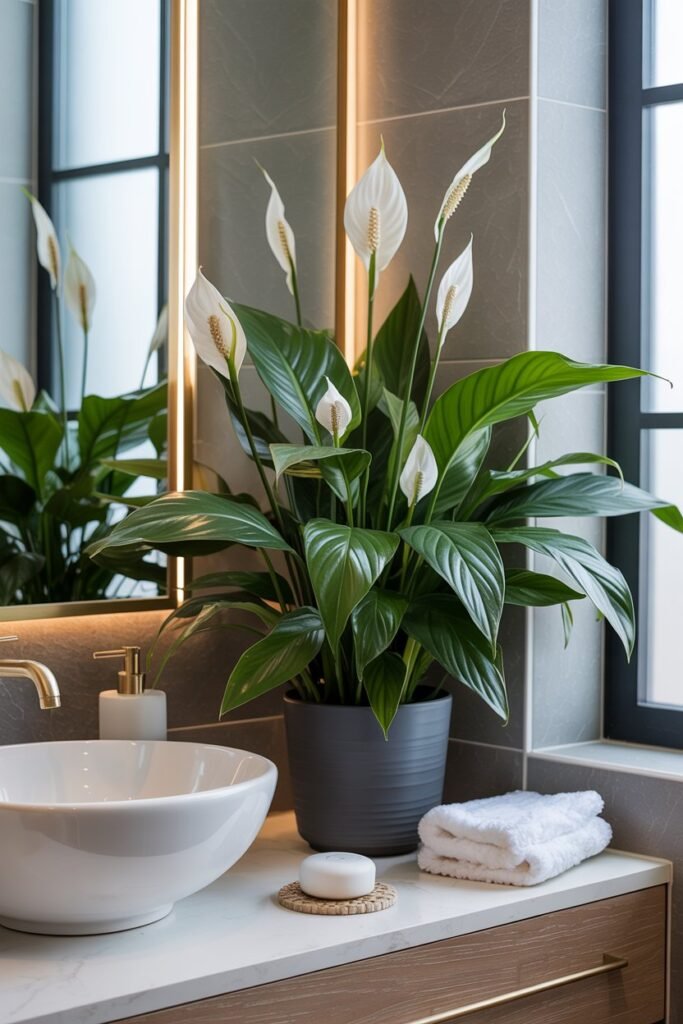
Its glossy, dark green leaves instantly brighten the space, and those occasional white blooms make the room feel elegant without requiring much effort.
Beyond looks, Peace Lilies are excellent for absorbing moisture and filtering indoor air, which makes them perfect for bathrooms.
How to Care for It:
- It tolerates low to medium light, so it’s great for bathrooms without large windows. I often place mine on a countertop or a small stool near indirect light.
- Keep the soil evenly moist. Peace Lilies will slightly droop when they’re thirsty, which I’ve found to be a helpful natural cue.
- Fertilize sparingly during the growing season to maintain vibrant leaves and encourage blooming.
Pro Tip: I place my Peace Lily near the shower or bathtub where it enjoys the daily humidity. I also like pairing it with a small, decorative tray to catch excess water and make the display feel intentional.
The combination of glossy leaves and white flowers adds a spa-like serenity to the bathroom that I absolutely love.
3. English Ivy (Hedera helix)
English Ivy is one of my favorite trailing plants for bathrooms because it loves humidity and is extremely versatile in terms of placement. I’ve used it in hanging planters, on shelves, and even allowed it to cascade down cabinet edges.
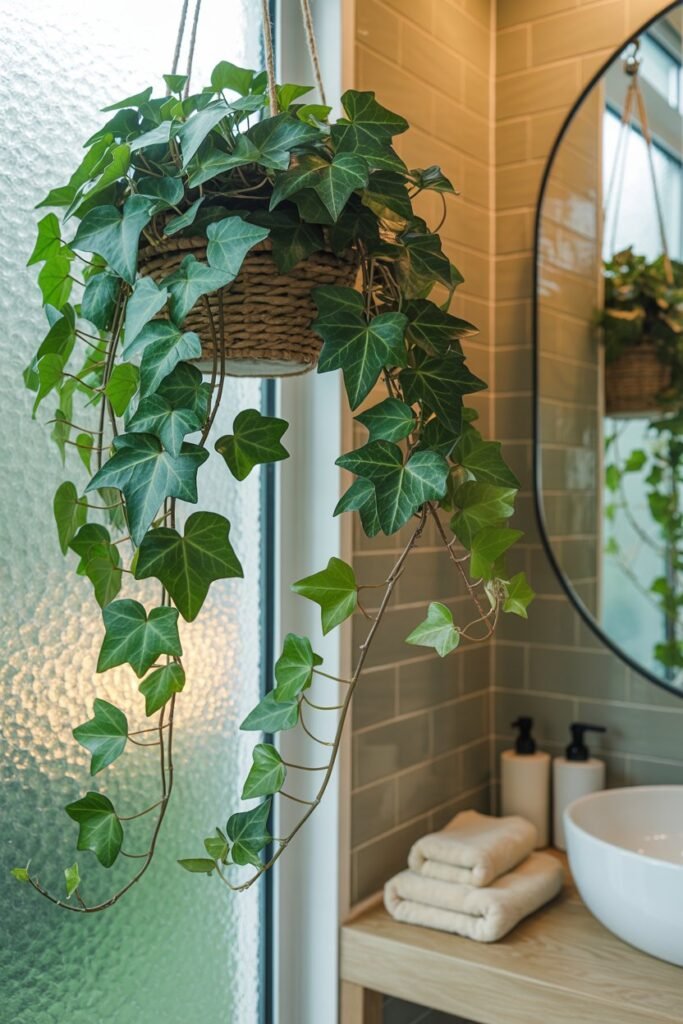
The trailing vines soften hard lines, add vertical interest, and naturally absorb excess moisture, helping to prevent that damp, musty feeling that can build up in bathrooms.
How to Care for It:
- Prefers bright, indirect light, though it can tolerate moderate shade. I’ve had success on shelves near frosted windows where it gets diffused sunlight.
- Keep the soil slightly moist, allowing the top layer to dry between watering. Overwatering can cause root rot, so I usually check the soil with my finger first.
- Trim regularly to maintain shape and encourage bushier growth. I like snipping a few leaves every couple of weeks to keep the vines healthy and controlled.
Pro Tip: Hanging English Ivy from a high shelf or letting it trail along a cabinet edge creates a natural, airy feel in the bathroom. I also like to combine it with smaller plants like ferns or succulents to create a layered green display.
Over time, the Ivy not only looks stunning but contributes to a fresher, more inviting environment by naturally absorbing moisture and improving air circulation.
4. Spider Plant (Chlorophytum comosum)
Spider Plants are one of my favorite easy-care plants for bathrooms. I first added one above my sink, and I was amazed at how quickly it adapted to the humidity.
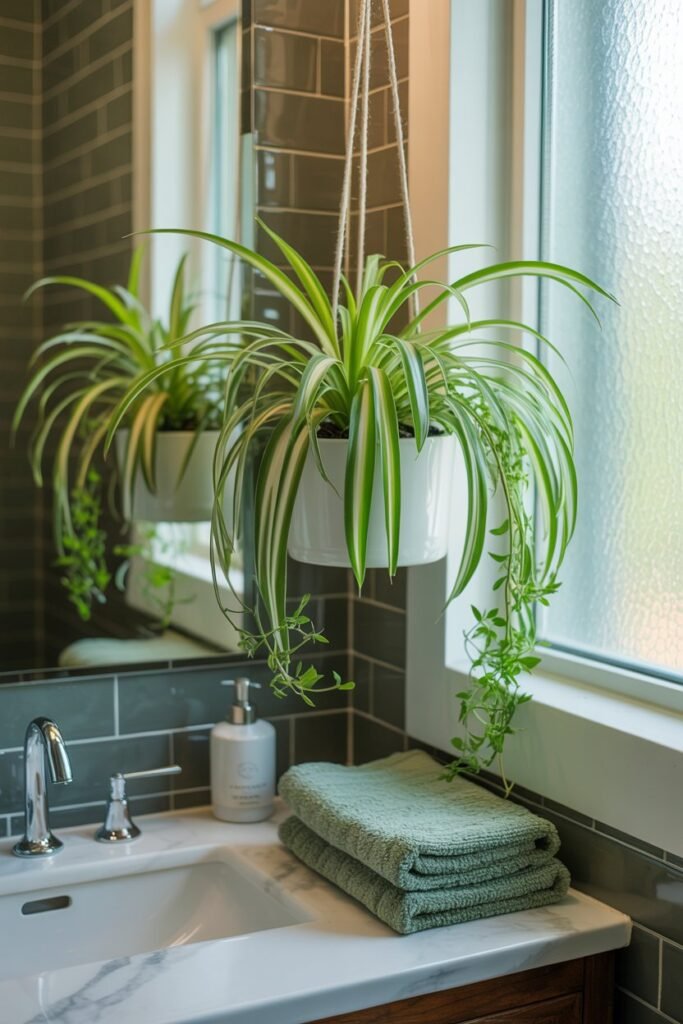
Its long, arching leaves bring life and movement to the space, and it’s surprisingly effective at absorbing moisture from the air, which helps keep the bathroom feeling fresher.
How to Care for It:
- Place in bright, indirect light. Spider Plants tolerate lower light but grow best near a window with filtered sunlight.
- Water moderately — the soil should stay slightly moist but not soggy. I usually water mine twice a week, adjusting based on humidity levels.
- Spider Plants produce small “babies” or offshoots, which I love to propagate in small pots around the bathroom.
Pro Tip: I like to hang mine in a small basket or macramé holder. The trailing leaves soften edges and create a natural focal point.
Plus, the babies add a playful touch, and I rotate them around other areas of the house for a continuous green theme.
5. Bamboo (Lucky Bamboo, Dracaena sanderiana)
Lucky Bamboo is another personal favorite, especially for bathrooms with limited space. I started placing a small stalk in a glass vase with water, and it immediately brightened the counter.

It thrives in humidity and is said to bring positive energy according to Feng Shui, which I like to believe enhances the calming feel of my bathroom.
How to Care for It:
- Keep the roots submerged in water and change it every 1–2 weeks to prevent stagnation.
- Place in indirect light — avoid direct sun which can scorch the leaves.
- You can add a few drops of liquid fertilizer monthly for growth, though it’s generally low-maintenance.
Pro Tip: I like arranging multiple stalks in a small vase with decorative pebbles. Not only does it look stylish, but it also doubles as a natural moisture absorber. Over time, the stalks grow taller, and the overall arrangement adds a zen-like, spa quality to the bathroom.
6. Aloe Vera (Aloe barbadensis)
Aloe Vera is a plant I’ve always loved for its practicality. Beyond its well-known medicinal properties, it thrives in humid bathroom environments.
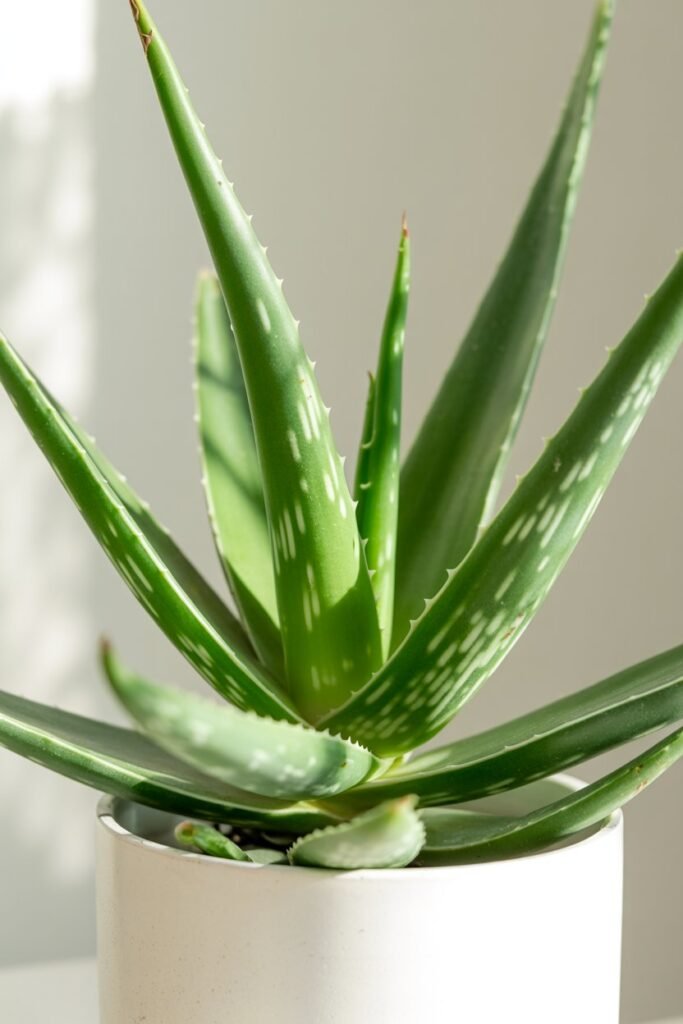
Its thick, fleshy leaves store water, allowing it to handle occasional neglect, and it contributes to humidity regulation in small spaces.
How to Care for It:
- Place near bright, indirect light — a sunny bathroom window works perfectly.
- Water sparingly, allowing the soil to dry out completely between watering. Overwatering can cause root rot.
- Aloe is low-maintenance and often needs repotting only once every couple of years.
Pro Tip: I like keeping a small pot of Aloe on the windowsill. Not only does it look modern and minimalistic, but it’s also handy for minor burns or skincare needs. Its upright growth contrasts nicely with trailing plants, creating visual interest in a small space.
7. Orchids (Phalaenopsis)
I was hesitant at first to put orchids in the bathroom, thinking the humidity might be too much. But I quickly discovered that bathroom humidity actually helps orchids thrive.
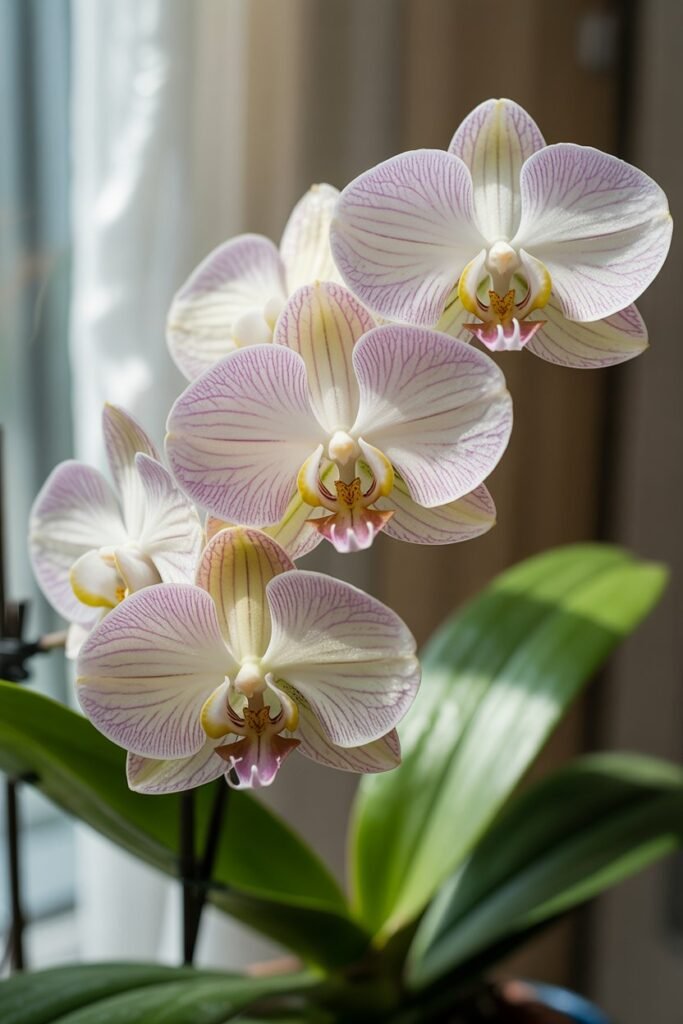
Their elegant flowers make the space feel luxurious, and they subtly help regulate moisture, especially in steamy showers.
How to Care for It:
- Place in indirect light. East-facing windows work beautifully, though any filtered light is fine.
- Water about once a week, ensuring the potting medium stays damp but not waterlogged.
- Feed with a balanced orchid fertilizer every month during the growing season to encourage blooms.
Pro Tip: I like placing orchids on the countertop or a small shelf where they are visible but not in direct water contact. Their long-lasting blooms add a pop of color and elegance, elevating the bathroom atmosphere while benefiting from the humidity.
8. Tillandsia (Air Plants)
Air plants are my favorite choice for bathrooms that don’t have much counter or floor space. These small, adaptable plants absorb moisture directly from the air, making them perfect for high-humidity environments.

I love decorating with them on shelves, in glass terrariums, or even hanging them from hooks.
How to Care for It:
- Place near indirect light or in a bright bathroom corner.
- Mist the plants 2–3 times a week to supplement humidity, or soak briefly every 1–2 weeks if your bathroom is dry.
- Air plants don’t need soil, which makes them perfect for small spaces or creative displays.
Pro Tip: I like grouping several air plants together in a glass container with pebbles or driftwood.
The display looks modern and artistic while taking full advantage of the bathroom’s moisture. They’re easy to rotate and rearrange, which makes the space feel dynamic and alive.
Final Thoughts
Adding moisture-absorbing plants to your bathroom is one of the simplest ways to combine beauty and functionality.
Over the years, I’ve noticed that these plants not only survive the humidity but actually thrive, creating a natural air-purifying effect while making the space feel fresh, spa-like, and inviting.
What I love most is how easy it is to personalize your selection. From lush ferns and elegant orchids to versatile air plants and bamboo, each plant brings its own charm and benefits.
By arranging them thoughtfully, keeping their care simple, and rotating scents or placements if desired, you can transform even the smallest bathroom into a vibrant, natural oasis.
FAQ
1. Which bathroom plants absorb the most moisture?
Boston Ferns, English Ivy, and Peace Lilies are among the best for absorbing humidity and improving air quality.
2. Can these plants survive in low-light bathrooms?
Yes, many of these plants tolerate low to medium light, such as Peace Lilies, English Ivy, and Spider Plants. Make sure to monitor their growth and adjust placement if needed.
3. How often should I water bathroom plants?
It depends on the species. Generally, ferns and Peace Lilies prefer consistently moist soil, while Aloe Vera and orchids need less frequent watering. Monitor soil moisture and adjust accordingly.
4. Can these plants prevent mold in the bathroom?
While they don’t eliminate mold entirely, moisture-absorbing plants help reduce excess humidity, which can lower the risk of mold formation.
5. Are these plants safe for pets and children?
Some plants, like Aloe Vera and English Ivy, can be toxic if ingested. Always place plants out of reach of pets or children or choose non-toxic alternatives like Spider Plants or Bamboo.

